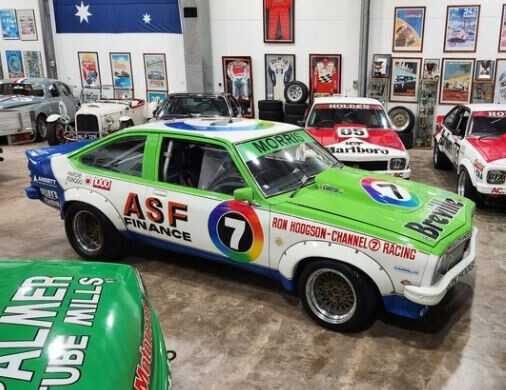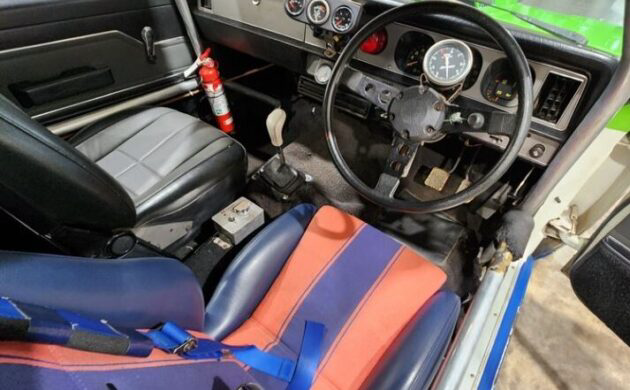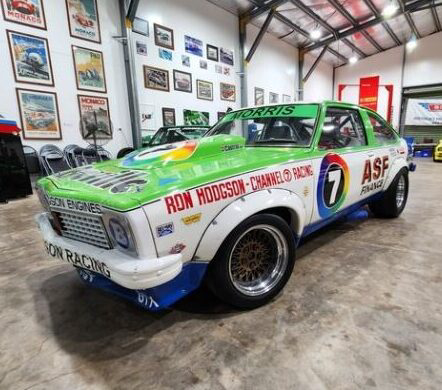Motorsport history is full of David versus Goliath stories, but none are better personified (autofied?) than by this 1977 Holden Toarana A9X Group C. It was one of two cars used by a privateer racer to defeat the Holden factory juggernaut to win the 1979 Australian Touring Car Championship (ATCC). It also hosted a long list of international drivers behind the wheel but is set to find a new home after a recent mechanical restoration. The Torana is listed here at Ecurie Bowden on the beautiful Sunshine Coast in Queensland, Australia. The seller doesn’t specify a price, but recent sales suggest it could threaten A$1,000,000.
Before we delve too deeply into this car’s specifications, it is probably worth providing some background information. Bob Morris was a supremely talented racer who never had the advantage of factory backing during his career. He achieved moderate success as a privateer but was largely overlooked by many spectators. That changed in 1976 when he and co-driver John Fitzpatrick scored a surprise win against the factory Holden and Ford teams in that year’s Bathurst 1000. It was one of the most dramatic finishes in the race’s history, with Fitzpatrick coaxing a clearly ailing car across the line at little more than walking pace. Morris continued racing in 1977 for Ron Hodgson Racing. Hodgson owned a Holden dealership and was very much a privateer receiving no factory assistance in his racing exploits. That first year of the partnership was hardly a banner one, with every Holden team soundly thrashed by the all-conquering Moffat Ford Dealer Team. However, salvation was at hand in the form of the A9X Torana. It dominated the Australian Touring Car Championship in 1978 and 1979 before being outlawed for 1980 as part of a restructure of the Touring Car regulations. Morris scored three race wins in 1978, but 1979 was his year. He used our feature car and its sibling to secure his only ATCC Championship crown. An ongoing lack of support saw Hodgson close down his team at the end of that year, and after some tentative outings with another team in early 1980, Morris went his own way with a Ford Falcon. He achieved limited success and looked a strong contender for a win in the 1981 Bathurst 1000 when he was involved in a race-ending accident. He seemed to walk away from the incident with only minor injuries, but nobody, Morris included, knew the full implications of the incident. He had suffered irreparable middle ear damage due to the impact, which negatively impacted his sense of balance. Bob made a couple of attempts to return to competition, but by 1984, he realized his position was untenable. Bob hung up his helmet and thus ended the career of one of Australian motorsport’s genuine greats.
Holden introduced its Torana A9X in 1977 as an evolution of the existing L34 model. It featured the same engine and transmission, but the rear end commanded all the attention. The L34 featured a “banjo” rear axle assembly and drum brakes. The banjo was extremely fragile and could not cope with the Torana’s engine power under competition conditions. Breakages were common, and drivers learned to “baby” their cars if they wished to finish any race. The A9X changed the game, featuring an upgraded Salisbury rear end and rear disc brakes. Once the initial bugs were ironed out, the A9X proved virtually unbeatable. This Torana started life as 1-of-33 GMP&A bodyshells that were walked down the production line. None of these cars featured a VIN, with GMP&A an acronym for General Motors Parts & Accessories. They were built to rolling stage but featured no sound-deadening material, extra welds for improved strength, and captive nuts welded in strategic places to attach a roll cage. These shells were designated for racing duty, although a few eventually made their way onto Australian streets and the pages of Barn Finds. This car’s body and paint are as it finished its last race, featuring the distinctive Green, White, and Blue paint combination designed by Bob Morris on a sheet of paper. It retains all of its correct signage and decals, with various surfaces wearing the chips and scratches that often accumulate in the heat of battle. However, there are no dings or dents and no signs of rust. This is understandable because the Torana spent over three decades in a climate-controlled museum once its racing career ended. It retains its correct fender flares, spoilers, and distinctive reverse hood scoop, while the wheels look like a combination of three-piece Simmons on the front and BBS on the back.
Powering this Torana is a 308ci V8 backed by a four-speed manual transmission. The 308 pumped out 220hp in production form, but under the watchful eye of legendary engine builder Peter Molloy, Bob Morris had 400hp under his right foot. If this vehicle is in race-ready condition, the transmission should be a Super T-10 unit. The power output figure might sound modest for a car of this type, but Group C race engines were the victim of some rather odd thinking by the governing body. Engine builders couldn’t increase an engine’s capacity, but they could use upgraded pistons, conrods, crankshafts, and carburetors. That sounds like a recipe for mega-power until you learn these motors had to retain their original production intake manifold. These were never intended for racing duty and failed to flow the air/fuel mixture efficiently. It is widely believed that 500hp would have been achievable with a better intake. After decades of inactivity, this car was handed to Tasmanian-based former driver and race engineer John Walker for a mechanical refresh. It was a thorough process, and potential buyers can consider this a race-ready package that runs and drives perfectly.
If the story of the engine intake seemed odd, there was an even stranger anomaly with Group C racecar interiors. Most people would expect to see an interior devoid of trim and upholstery, but the production basis of the category required cars to retain their complete interior. This meant all seats, the upholstery, and the carpet, were intact. The dash had to house items like its radio, while components like heater cores could not be removed. Holden recognized that extra weight equated to a potential performance loss. Therefore, the A9X came from the factory with no luxury equipment like a radio or console, although these were available if a buyer asked. Builders could make changes to improve safety and reliability. This included a compulsory roll cage, a six-point racing harness, a proper competition-bred driver’s seat, and additional gauges to monitor the car’s mechanical health. This interior is in as-raced condition, although it features the wrong driver’s seat. That is a shame because the original seat accommodated some pretty illustrious names. These included Derek Bell, Dieter Quester, Janet Guthrie, and Johnny Rutherford. The interior presents well, with no apparent needs or shortcomings.
This 1977 Holden Torana A9X Group C is part of Australian motor racing folklore, and its against-the-odds championship victory in 1979 makes it an extraordinarily significant machine. Prices for classic Australian racers have climbed substantially over the past decade, but the increases have been stratospheric following the demise of the country’s vehicle manufacturing industry. With the decision by General Motors to retire the Holden brand, it falls to cars like this to provide an insight into an era when Holden’s position in the market and on the track seemed unassailable. That is why I believe it will achieve the quoted figure and will probably do so reasonably quickly.













I’ve never seen a race car before that was sponsored by a company (Breville) that makes toaster ovens and microwaves. Perhaps there is a rotary dial on the dash that you turn from “toast” or “broil” to “race”. Push the button next to it and you’re off…
P.S.- Breville is seriously the best built, longest lasting appliance brand that we have encountered. Expensive, but they seem to last forever (I am not paid for this- just my opinion).
Beautiful piece of Aust.race history.Will go to a serious collector.
Oddly, IMO, the later front drive USA Chevy Citation 2 door has a body similar to this car!
Vega/Monza
AMC Eagle/Chevy Citation stepchild looking thing.
These Aussie cars are a total yawn 🥱 for me.
Curiously, they do bring alot of money when sold.
These cars are legendary down under. The Australian Peter Brock won Bathurst in 1979 i think. He won against the gig Ford falcons by about 7 laps and the car was running so strong he set a lap record on his last lap with his arm hanging out the door. Beautifully balanced race car in the A9X configuration.
I would also comment that over the years alot of American muscle tried winning Bathurst along with British makes like jaguar and they couldn’t foot it with the locals (other than the 1985 Jaguar win). In saying that the race these days is between the Mustangs and the camaro’s. The mercedes Amg were represented for a while but couldnt get close to the HSV Holdens. Here is brocks last lap or two in 1979
https://www.youtube.com/watch?v=JC9NAhlsxUU